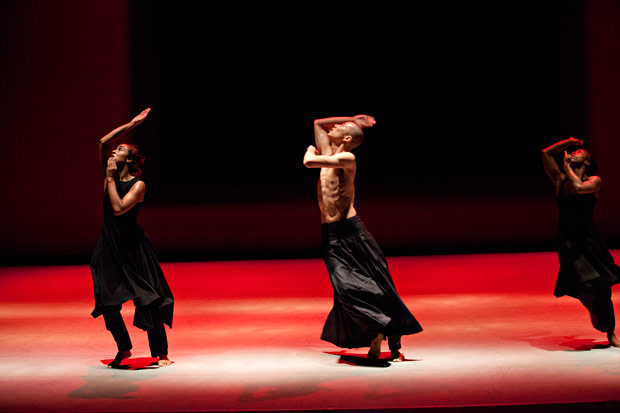
© Louis Fernandez. (Click image for larger version)
Akram Khan Company
Kaash
★★★★✰
London, Sadler’s Wells
3 March 2016
www.akramkhancompany.net
www.sadlerswells.com
Akram Khan created Kaash in 2002 as his first full-length work for his company, an attempt to fuse contemporary dance with his Indian kathak training. I saw it that year at the Queen Elizabeth Hall. What made a strong impression at the time were the brilliance of Khan as a dancer and the striking contributions of his collaborators. Kaash was very well received at the time, a real breakthrough piece. Now it has been revived and revised for his company and Khan no longer appears in it. He has stated he will give up performing altogether by 2018. It’s difficult to watch the work without recalling memories of his astonishing speed and fluency. However many of the audience (in this sold out run) will be viewing the work for the first time and judging its merits on how it is performed now.

© Louis Fernandez. (Click image for larger version)
Even without Khan’s charismatic presence Kaash is a fiercely physical and engrossing hour in the theatre, and the dancers, who have been performing in this revival since 2014, for the most part claim it as their own. It has been reworked for five performers rather than the original six, three women and two men. Many original features remain the same. Khan’s collaborators were the sculptor Anish Kapoor who designed the backdrop, and Nitin Sawhney who provided music and soundtrack. Kapoor’s giant black rectangle on the backdrop is visible as soon as we enter the auditorium. It almost seems to have a life of its own, seemingly becoming steadily deeper, even blacker, and threatening to suck the performers into its vortex. The lighting by Aideen Malone provides washes of red, yellow or blue to surround the black void, and corridors of white light for the performers to negotiate. Sawhney’s soundtrack ranges from whispers to thunderously loud cosmic rumblings that make the floor shake. This is appropriate for a work (Kaash means “if only”) that had its origins in thoughts about Hindu cosmology, theoretical physics and possible parallel universes. The soundtrack offers noises of destruction or possibly creation or but the dance itself offers no narrative.
The work opens with one man standing gazing into the black void of the backdrop, lit from the side. Sawhney’s soundtrack is percussive and rumbling. In this first section, often one dancer is opposed against the other four. Sometimes a solo is watched by the rest, but often they turn their backs to the audience and gaze into the backdrop, a recurring theme. The dance language doesn’t differ much between the men and women. All wear black trousers. The men are bare-chested but wear wide skirts, and the women full skirted dresses, all set swirling by whirling turns.

© Louis Fernandez. (Click image for larger version)
The second section begins in silence with a long solo that then becomes a duet. This is the only glimpse of partnering in the piece where men and women seldom touch. Was the partnering perhaps added in the rework? One wonders how much the revised choreography incorporates newer ideas from Khan. One of the men covers his face with his hand in a gesture uncannily similar to one repeatedly used in Khan’s recent Until the Lions. This section appears more kathak influenced with its filigree hand gestures and the audible slap of feet against the floor. This is reinforced by a voiceover counting out the complex Indian rhythms. It’s disconcerting to realise that the voice is Khan’s. The dancers had made such a strong case for the work up to that point that it was jarring to be reminded of his absence.
The dancers are an interesting mix. Twin sisters Kristina Alleyne and Sadé Alleyne both originally trained as athletes and they have a full blooded physicality and uncompromising fierceness. Sun Hoon Kim is a complete contrast, a more ethereal presence, slowly unfurling his long pale arms and demonstrating his supple back.
The audience response was very positive. It’s impossible not to miss Khan the performer but his dancers have reanimated this work and make a persuasive case for the revival.












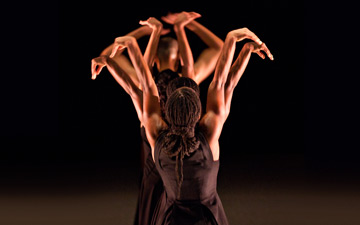
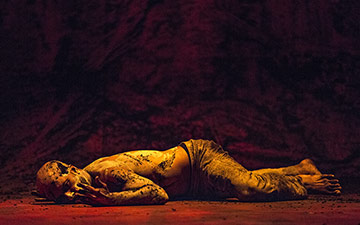
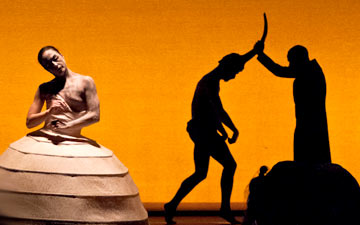

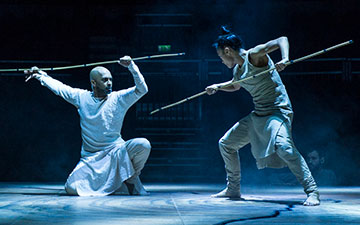
You must be logged in to post a comment.